coolant TOYOTA RAV4 1996 Service Repair Manual
[x] Cancel search | Manufacturer: TOYOTA, Model Year: 1996, Model line: RAV4, Model: TOYOTA RAV4 1996Pages: 1632, PDF Size: 41.64 MB
Page 123 of 1632
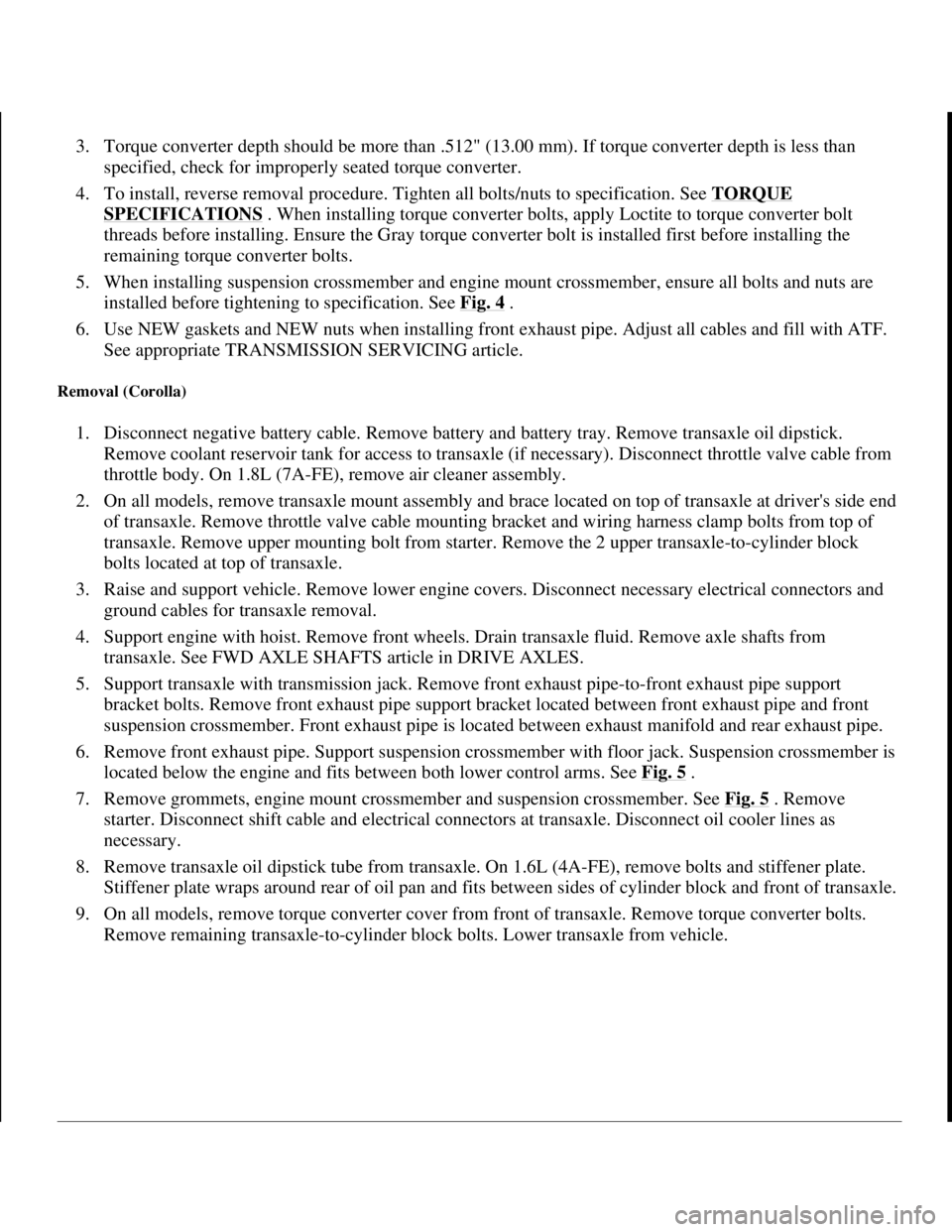
3. Torque converter depth should be more than .512" (13.00 mm). If torque converter depth is less than
specified, check for improperly seated torque converter.
4. To install, reverse removal procedure. Tighten all bolts/nuts to specification. See TORQUE
SPECIFICATIONS . When installing torque converter bolts, apply Loctite to torque converter bolt
threads before installing. Ensure the Gray torque converter bolt is installed first before installing the
remaining torque converter bolts.
5. When installing suspension crossmember and engine mount crossmember, ensure all bolts and nuts are
installed before tightening to specification. See Fig. 4
.
6. Use NEW gaskets and NEW nuts when installing front exhaust pipe. Adjust all cables and fill with ATF.
See appropriate TRANSMISSION SERVICING article.
Removal (Corolla)
1. Disconnect negative battery cable. Remove battery and battery tray. Remove transaxle oil dipstick.
Remove coolant reservoir tank for access to transaxle (if necessary). Disconnect throttle valve cable from
throttle body. On 1.8L (7A-FE), remove air cleaner assembly.
2. On all models, remove transaxle mount assembly and brace located on top of transaxle at driver's side end
of transaxle. Remove throttle valve cable mounting bracket and wiring harness clamp bolts from top of
transaxle. Remove upper mounting bolt from starter. Remove the 2 upper transaxle-to-cylinder block
bolts located at top of transaxle.
3. Raise and support vehicle. Remove lower engine covers. Disconnect necessary electrical connectors and
ground cables for transaxle removal.
4. Support engine with hoist. Remove front wheels. Drain transaxle fluid. Remove axle shafts from
transaxle. See FWD AXLE SHAFTS article in DRIVE AXLES.
5. Support transaxle with transmission jack. Remove front exhaust pipe-to-front exhaust pipe support
bracket bolts. Remove front exhaust pipe support bracket located between front exhaust pipe and front
suspension crossmember. Front exhaust pipe is located between exhaust manifold and rear exhaust pipe.
6. Remove front exhaust pipe. Support suspension crossmember with floor jack. Suspension crossmember is
located below the engine and fits between both lower control arms. See Fig. 5
.
7. Remove grommets, engine mount crossmember and suspension crossmember. See Fig. 5
. Remove
starter. Disconnect shift cable and electrical connectors at transaxle. Disconnect oil cooler lines as
necessary.
8. Remove transaxle oil dipstick tube from transaxle. On 1.6L (4A-FE), remove bolts and stiffener plate.
Stiffener plate wraps around rear of oil pan and fits between sides of cylinder block and front of transaxle.
9. On all models, remove torque converter cover from front of transaxle. Remove torque converter bolts.
Remove remainin
g transaxle-to-cylinder block bolts. Lower transaxle from vehicle.
1998 Toyota Avalon XLS
TRANSMISSION SERVICING - A/T 1997-98 TRANSMISSION SERVICING Toyota - Transmission Removal &
Installation
Helpmelearn
November-03-08 10:30:28 AMPage 11 © 2005 Mitchell Repair Information Company, LLC.
Page 131 of 1632
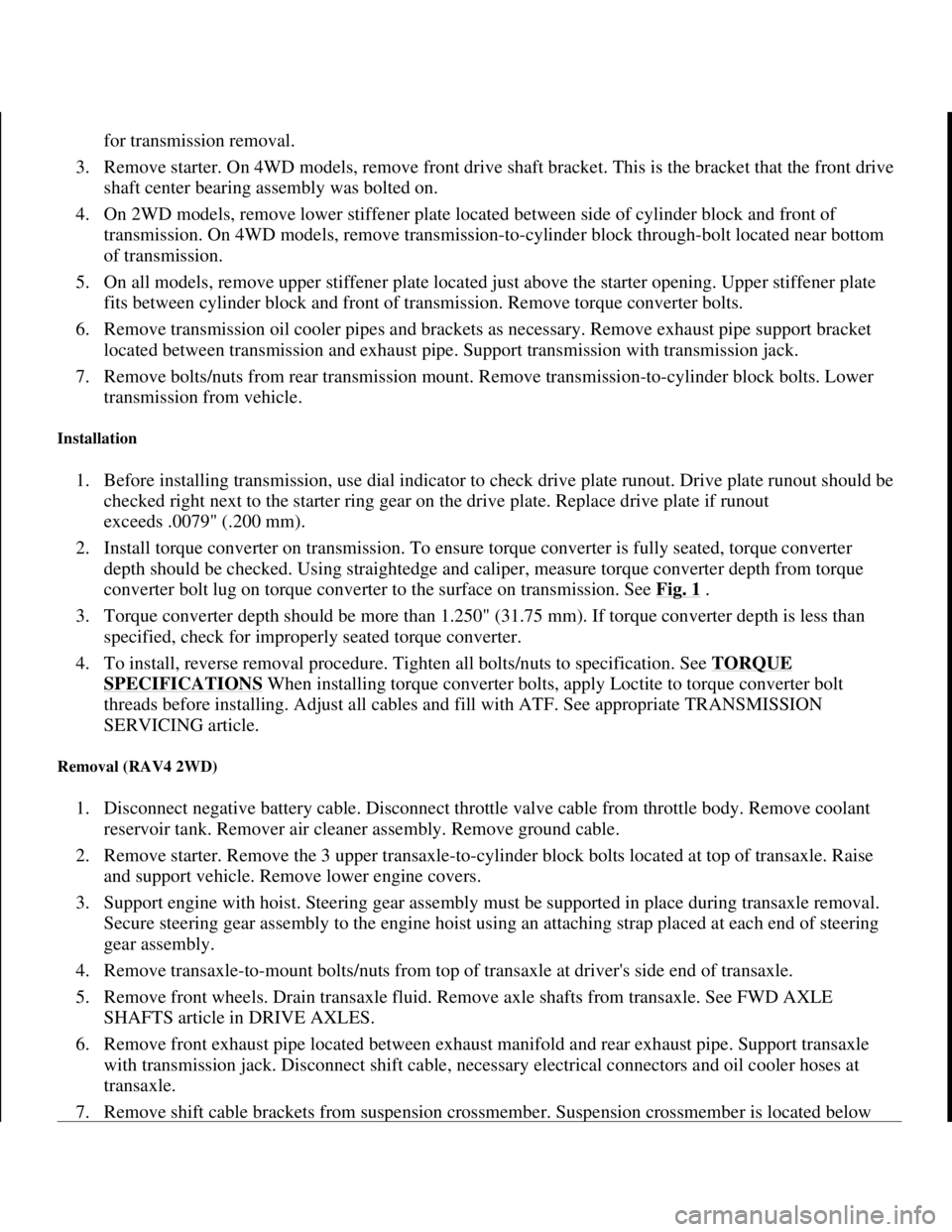
for transmission removal.
3. Remove starter. On 4WD models, remove front drive shaft bracket. This is the bracket that the front drive
shaft center bearing assembly was bolted on.
4. On 2WD models, remove lower stiffener plate located between side of cylinder block and front of
transmission. On 4WD models, remove transmission-to-cylinder block through-bolt located near bottom
of transmission.
5. On all models, remove upper stiffener plate located just above the starter opening. Upper stiffener plate
fits between cylinder block and front of transmission. Remove torque converter bolts.
6. Remove transmission oil cooler pipes and brackets as necessary. Remove exhaust pipe support bracket
located between transmission and exhaust pipe. Support transmission with transmission jack.
7. Remove bolts/nuts from rear transmission mount. Remove transmission-to-cylinder block bolts. Lower
transmission from vehicle.
Installation
1. Before installing transmission, use dial indicator to check drive plate runout. Drive plate runout should be
checked right next to the starter ring gear on the drive plate. Replace drive plate if runout
exceeds .0079" (.200 mm).
2. Install torque converter on transmission. To ensure torque converter is fully seated, torque converter
depth should be checked. Using straightedge and caliper, measure torque converter depth from torque
converter bolt lug on torque converter to the surface on transmission. See Fig. 1
.
3. Torque converter depth should be more than 1.250" (31.75 mm). If torque converter depth is less than
specified, check for improperly seated torque converter.
4. To install, reverse removal procedure. Tighten all bolts/nuts to specification. See TORQUE
SPECIFICATIONS When installing torque converter bolts, apply Loctite to torque converter bolt
threads before installing. Adjust all cables and fill with ATF. See appropriate TRANSMISSION
SERVICING article.
Removal (RAV4 2WD)
1. Disconnect negative battery cable. Disconnect throttle valve cable from throttle body. Remove coolant
reservoir tank. Remover air cleaner assembly. Remove ground cable.
2. Remove starter. Remove the 3 upper transaxle-to-cylinder block bolts located at top of transaxle. Raise
and support vehicle. Remove lower engine covers.
3. Support engine with hoist. Steering gear assembly must be supported in place during transaxle removal.
Secure steering gear assembly to the engine hoist using an attaching strap placed at each end of steering
gear assembly.
4. Remove transaxle-to-mount bolts/nuts from top of transaxle at driver's side end of transaxle.
5. Remove front wheels. Drain transaxle fluid. Remove axle shafts from transaxle. See FWD AXLE
SHAFTS article in DRIVE AXLES.
6. Remove front exhaust pipe located between exhaust manifold and rear exhaust pipe. Support transaxle
with transmission jack. Disconnect shift cable, necessary electrical connectors and oil cooler hoses at
transaxle.
7. Remove shift cable brackets from suspension crossmember. Suspension crossmember is located below
1998 Toyota Avalon XLS
TRANSMISSION SERVICING - A/T 1997-98 TRANSMISSION SERVICING Toyota - Transmission Removal &
Installation
Helpmelearn
November-03-08 10:30:28 AMPage 19 © 2005 Mitchell Repair Information Company, LLC.
Page 161 of 1632
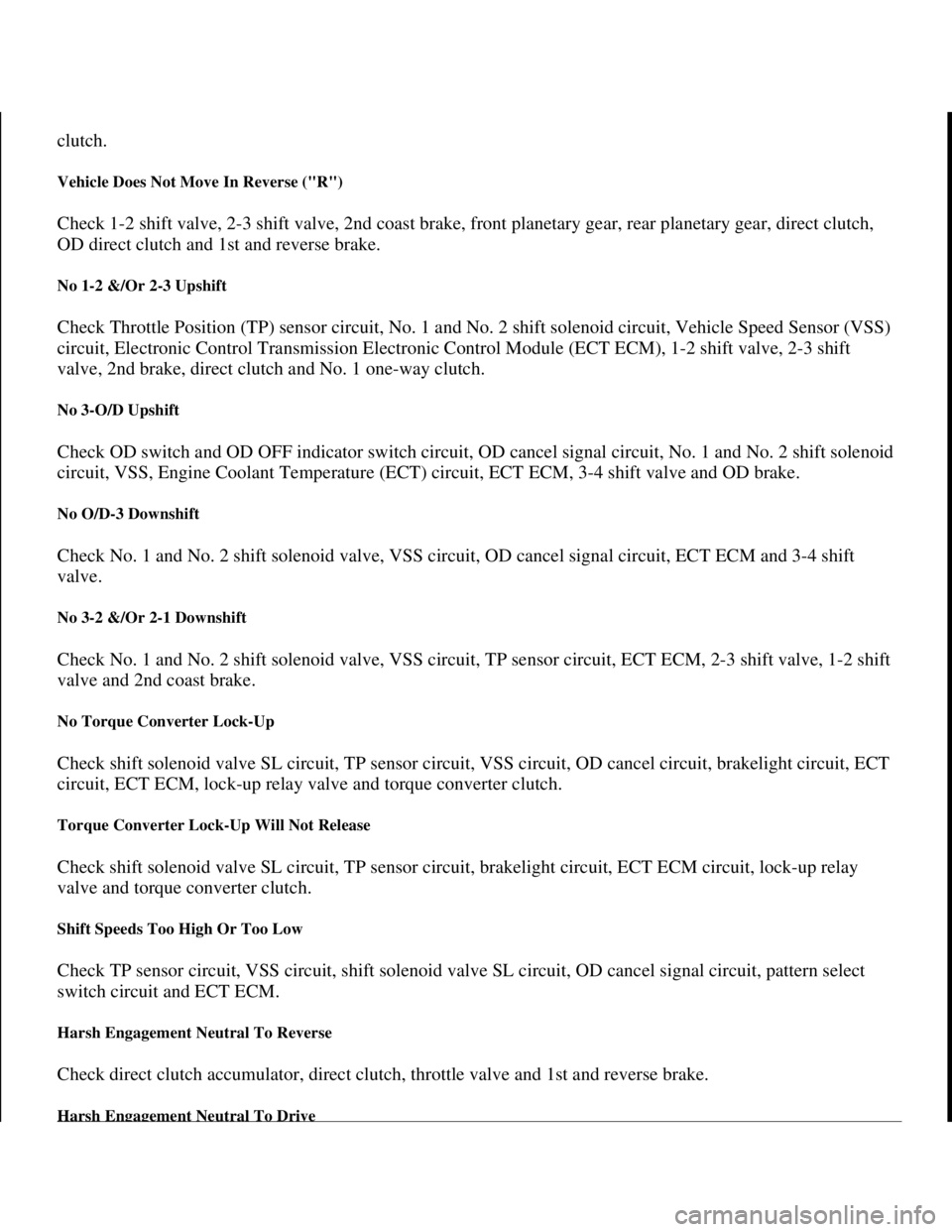
clutch.
Vehicle Does Not Move In Reverse ("R")
Check 1-2 shift valve, 2-3 shift valve, 2nd coast brake, front planetary gear, rear planetary gear, direct clutch,
OD direct clutch and 1st and reverse brake.
No 1-2 &/Or 2-3 Upshift
Check Throttle Position (TP) sensor circuit, No. 1 and No. 2 shift solenoid circuit, Vehicle Speed Sensor (VSS)
circuit, Electronic Control Transmission Electronic Control Module (ECT ECM), 1-2 shift valve, 2-3 shift
valve, 2nd brake, direct clutch and No. 1 one-way clutch.
No 3-O/D Upshift
Check OD switch and OD OFF indicator switch circuit, OD cancel signal circuit, No. 1 and No. 2 shift solenoid
circuit, VSS, Engine Coolant Temperature (ECT) circuit, ECT ECM, 3-4 shift valve and OD brake.
No O/D-3 Downshift
Check No. 1 and No. 2 shift solenoid valve, VSS circuit, OD cancel signal circuit, ECT ECM and 3-4 shift
valve.
No 3-2 &/Or 2-1 Downshift
Check No. 1 and No. 2 shift solenoid valve, VSS circuit, TP sensor circuit, ECT ECM, 2-3 shift valve, 1-2 shift
valve and 2nd coast brake.
No Torque Converter Lock-Up
Check shift solenoid valve SL circuit, TP sensor circuit, VSS circuit, OD cancel circuit, brakelight circuit, ECT
circuit, ECT ECM, lock-up relay valve and torque converter clutch.
Torque Converter Lock-Up Will Not Release
Check shift solenoid valve SL circuit, TP sensor circuit, brakelight circuit, ECT ECM circuit, lock-up relay
valve and torque converter clutch.
Shift Speeds Too High Or Too Low
Check TP sensor circuit, VSS circuit, shift solenoid valve SL circuit, OD cancel signal circuit, pattern select
switch circuit and ECT ECM.
Harsh Engagement Neutral To Reverse
Check direct clutch accumulator, direct clutch, throttle valve and 1st and reverse brake.
Harsh Engagement Neutral To Drive
1998 Toyota Avalon XLS
1997-99 AUTOMATIC TRANSMISSIONS Toyota A-540E, A-540H & A-541E Overhaul
Helpmelearn
November-03-08 10:28:16 AMPage 7 © 2005 Mitchell Repair Information Company, LLC.
Page 164 of 1632
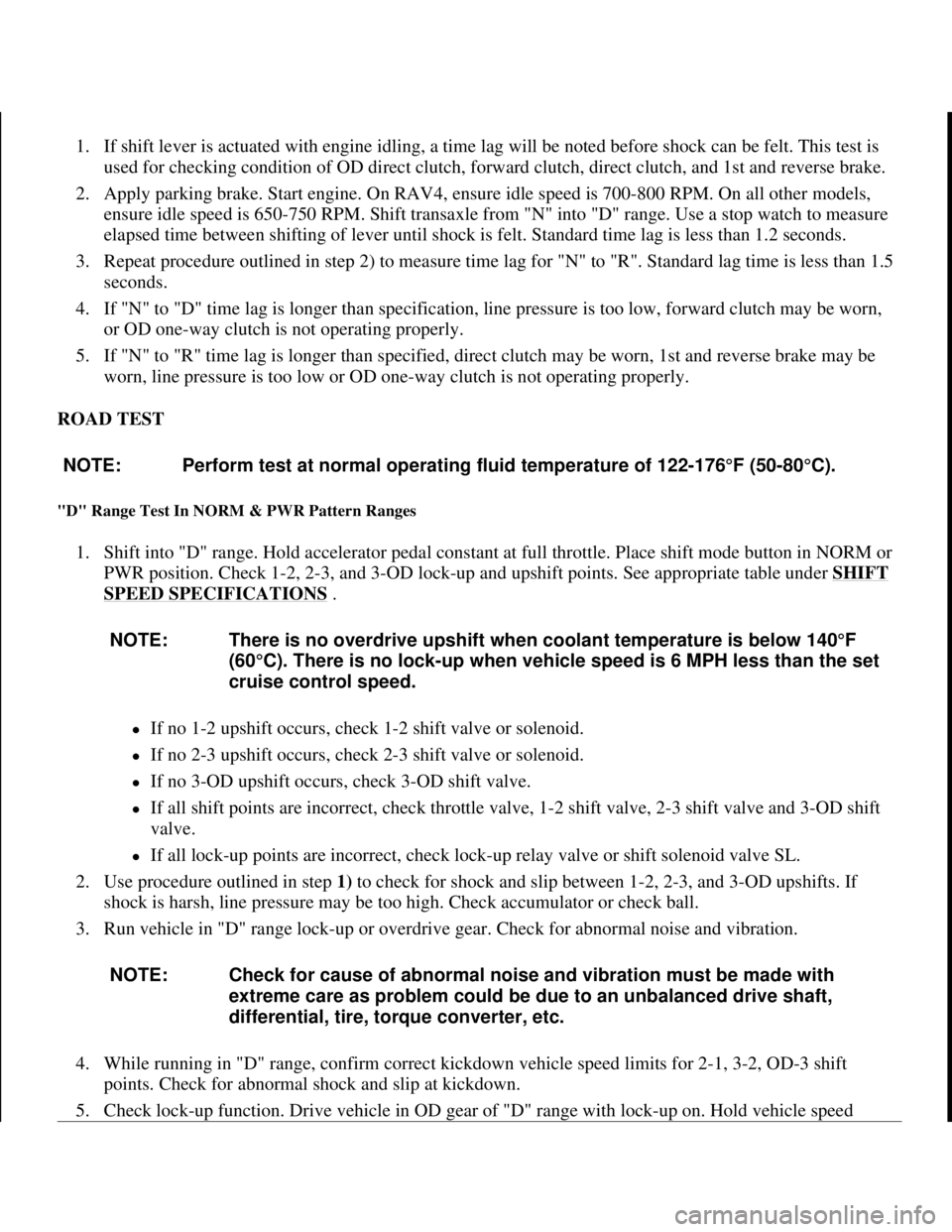
1. If shift lever is actuated with engine idling, a time lag will be noted before shock can be felt. This test is
used for checking condition of OD direct clutch, forward clutch, direct clutch, and 1st and reverse brake.
2. Apply parking brake. Start engine. On RAV4, ensure idle speed is 700-800 RPM. On all other models,
ensure idle speed is 650-750 RPM. Shift transaxle from "N" into "D" range. Use a stop watch to measure
elapsed time between shifting of lever until shock is felt. Standard time lag is less than 1.2 seconds.
3. Repeat procedure outlined in step 2) to measure time lag for "N" to "R". Standard lag time is less than 1.5
seconds.
4. If "N" to "D" time lag is longer than specification, line pressure is too low, forward clutch may be worn,
or OD one-way clutch is not operating properly.
5. If "N" to "R" time lag is longer than specified, direct clutch may be worn, 1st and reverse brake may be
worn, line pressure is too low or OD one-way clutch is not operating properly.
ROAD TEST
"D" Range Test In NORM & PWR Pattern Ranges
1. Shift into "D" range. Hold accelerator pedal constant at full throttle. Place shift mode button in NORM or
PWR position. Check 1-2, 2-3, and 3-OD lock-up and upshift points. See appropriate table under SHIFT
SPEED SPECIFICATIONS .
�zIf no 1-2 upshift occurs, check 1-2 shift valve or solenoid.
�zIf no 2-3 upshift occurs, check 2-3 shift valve or solenoid.
�zIf no 3-OD upshift occurs, check 3-OD shift valve.
�zIf all shift points are incorrect, check throttle valve, 1-2 shift valve, 2-3 shift valve and 3-OD shift
valve.
�zIf all lock-up points are incorrect, check lock-up relay valve or shift solenoid valve SL.
2. Use procedure outlined in step 1) to check for shock and slip between 1-2, 2-3, and 3-OD upshifts. If
shock is harsh, line pressure may be too high. Check accumulator or check ball.
3. Run vehicle in "D" range lock-up or overdrive gear. Check for abnormal noise and vibration.
4. While running in "D" range, confirm correct kickdown vehicle speed limits for 2-1, 3-2, OD-3 shift
points. Check for abnormal shock and slip at kickdown.
5. Check loc
k-up function. Drive vehicle in OD gear of "D" range with lock-up on. Hold vehicle speed NOTE: Perform test at normal operating fluid temperature of 122-176°F (50-80°C).
NOTE: There is no overdrive upshift when coolant temperature is below 140°F
(60°C). There is no lock-up when vehicle speed is 6 MPH less than the set
cruise control speed.
NOTE: Check for cause of abnormal noise and vibration must be made with
extreme care as problem could be due to an unbalanced drive shaft,
differential, tire, torque converter, etc.
1998 Toyota Avalon XLS
1997-99 AUTOMATIC TRANSMISSIONS Toyota A-540E, A-540H & A-541E Overhaul
Helpmelearn
November-03-08 10:28:17 AMPage 10 © 2005 Mitchell Repair Information Company, LLC.
Page 408 of 1632
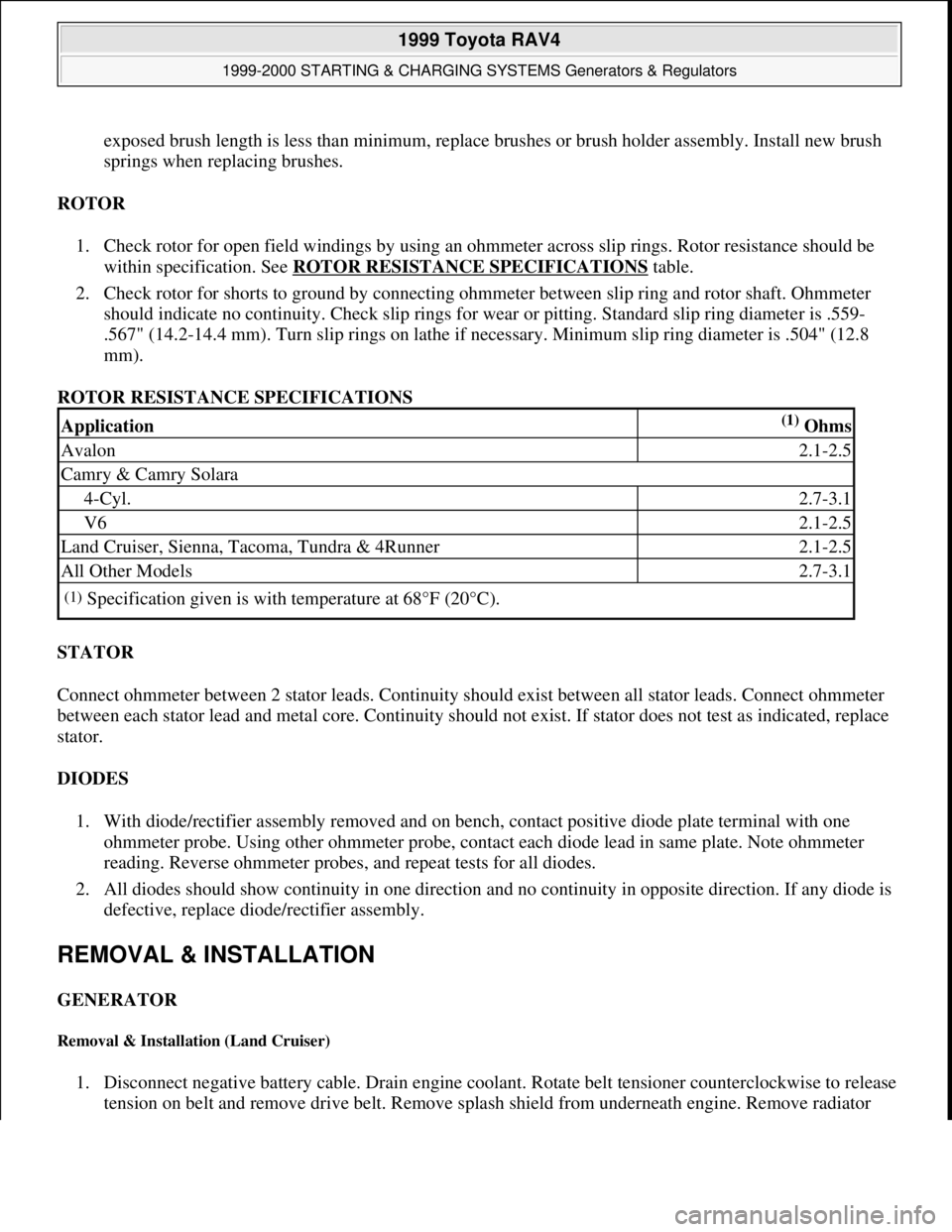
exposed brush length is less than minimum, replace brushes or brush holder assembly. Install new brush
springs when replacing brushes.
ROTOR
1. Check rotor for open field windings by using an ohmmeter across slip rings. Rotor resistance should be
within specification. See ROTOR RESISTANCE SPECIFICATIONS
table.
2. Check rotor for shorts to ground by connecting ohmmeter between slip ring and rotor shaft. Ohmmeter
should indicate no continuity. Check slip rings for wear or pitting. Standard slip ring diameter is .559-
.567" (14.2-14.4 mm). Turn slip rings on lathe if necessary. Minimum slip ring diameter is .504" (12.8
mm).
ROTOR RESISTANCE SPECIFICATIONS
STATOR
Connect ohmmeter between 2 stator leads. Continuity should exist between all stator leads. Connect ohmmeter
between each stator lead and metal core. Continuity should not exist. If stator does not test as indicated, replace
stator.
DIODES
1. With diode/rectifier assembly removed and on bench, contact positive diode plate terminal with one
ohmmeter probe. Using other ohmmeter probe, contact each diode lead in same plate. Note ohmmeter
reading. Reverse ohmmeter probes, and repeat tests for all diodes.
2. All diodes should show continuity in one direction and no continuity in opposite direction. If any diode is
defective, replace diode/rectifier assembly.
REMOVAL & INSTALLATION
GENERATOR
Removal & Installation (Land Cruiser)
1. Disconnect negative battery cable. Drain engine coolant. Rotate belt tensioner counterclockwise to release
tension on belt and remove drive belt. Remove splash shield from underneath en
gine. Remove radiator
Application(1) Ohms
Avalon2.1-2.5
Camry & Camry Solara
4-Cyl.2.7-3.1
V62.1-2.5
Land Cruiser, Sienna, Tacoma, Tundra & 4Runner2.1-2.5
All Other Models2.7-3.1
(1)Specification given is with temperature at 68°F (20°C).
1999 Toyota RAV4
1999-2000 STARTING & CHARGING SYSTEMS Generators & Regulators
Microsoft
Sunday, November 22, 2009 10:13:07 AMPage 7 © 2005 Mitchell Repair Information Company, LLC.
Page 471 of 1632
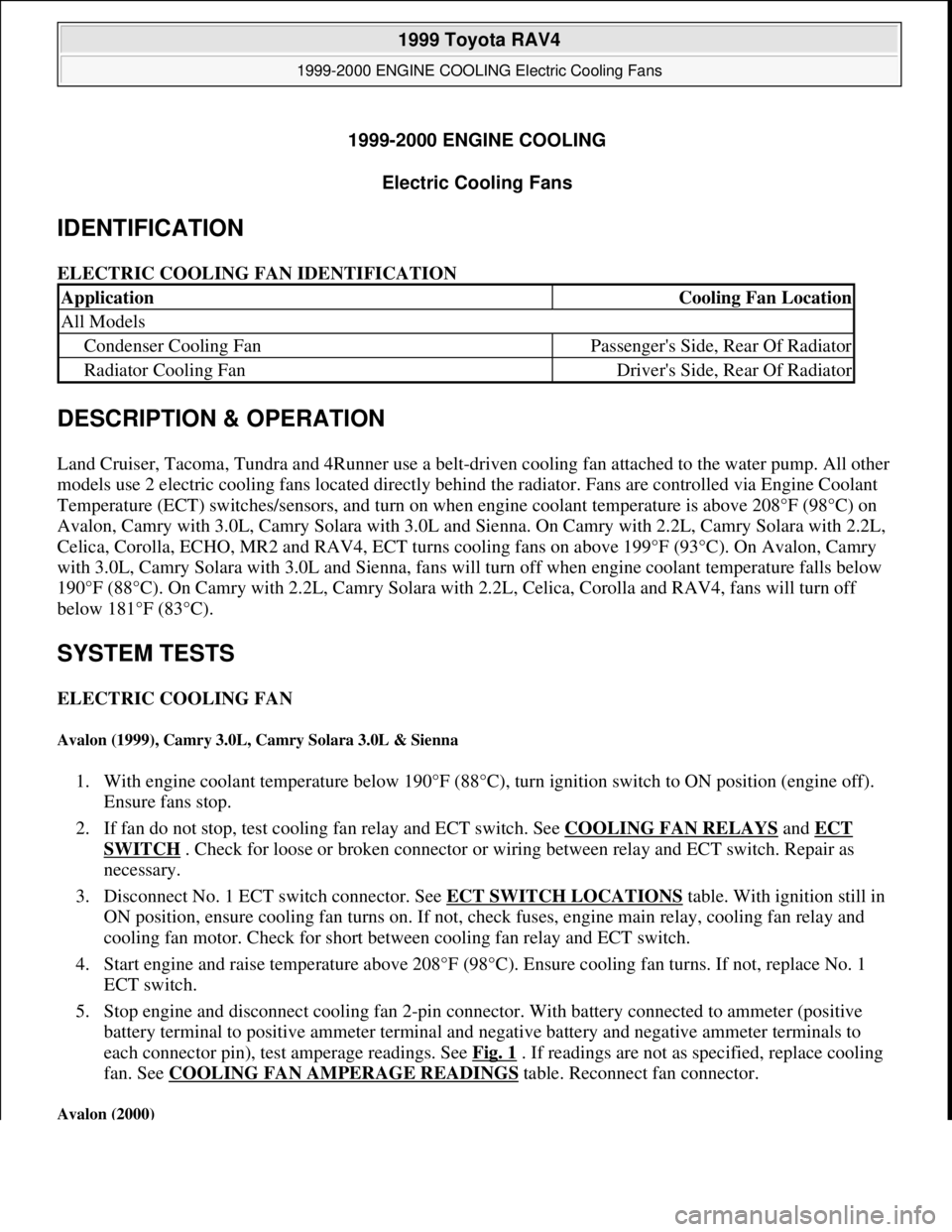
1999-2000 ENGINE COOLING
Electric Cooling Fans
IDENTIFICATION
ELECTRIC COOLING FAN IDENTIFICATION
DESCRIPTION & OPERATION
Land Cruiser, Tacoma, Tundra and 4Runner use a belt-driven cooling fan attached to the water pump. All other
models use 2 electric cooling fans located directly behind the radiator. Fans are controlled via Engine Coolant
Temperature (ECT) switches/sensors, and turn on when engine coolant temperature is above 208°F (98°C) on
Avalon, Camry with 3.0L, Camry Solara with 3.0L and Sienna. On Camry with 2.2L, Camry Solara with 2.2L,
Celica, Corolla, ECHO, MR2 and RAV4, ECT turns cooling fans on above 199°F (93°C). On Avalon, Camry
with 3.0L, Camry Solara with 3.0L and Sienna, fans will turn off when engine coolant temperature falls below
190°F (88°C). On Camry with 2.2L, Camry Solara with 2.2L, Celica, Corolla and RAV4, fans will turn off
below 181°F (83°C).
SYSTEM TESTS
ELECTRIC COOLING FAN
Avalon (1999), Camry 3.0L, Camry Solara 3.0L & Sienna
1. With engine coolant temperature below 190°F (88°C), turn ignition switch to ON position (engine off).
Ensure fans stop.
2. If fan do not stop, test cooling fan relay and ECT switch. See COOLING FAN RELAYS
and ECT
SWITCH . Check for loose or broken connector or wiring between relay and ECT switch. Repair as
necessary.
3. Disconnect No. 1 ECT switch connector. See ECT SWITCH LOCATIONS
table. With ignition still in
ON position, ensure cooling fan turns on. If not, check fuses, engine main relay, cooling fan relay and
cooling fan motor. Check for short between cooling fan relay and ECT switch.
4. Start engine and raise temperature above 208°F (98°C). Ensure cooling fan turns. If not, replace No. 1
ECT switch.
5. Stop engine and disconnect cooling fan 2-pin connector. With battery connected to ammeter (positive
battery terminal to positive ammeter terminal and negative battery and negative ammeter terminals to
each connector pin), test amperage readings. See Fig. 1
. If readings are not as specified, replace cooling
fan. See COOLING FAN AMPERAGE READINGS
table. Reconnect fan connector.
Avalon (2000)
ApplicationCooling Fan Location
All Models
Condenser Cooling FanPassenger's Side, Rear Of Radiator
Radiator Cooling FanDriver's Side, Rear Of Radiator
1999 Toyota RAV4
1999-2000 ENGINE COOLING Electric Cooling Fans
1999 Toyota RAV4
1999-2000 ENGINE COOLING Electric Cooling Fans
Microsoft
Sunday, November 22, 2009 10:21:41 AMPage 1 © 2005 Mitchell Repair Information Company, LLC.
Microsoft
Sunday, November 22, 2009 10:21:45 AMPage 1 © 2005 Mitchell Repair Information Company, LLC.
Page 472 of 1632
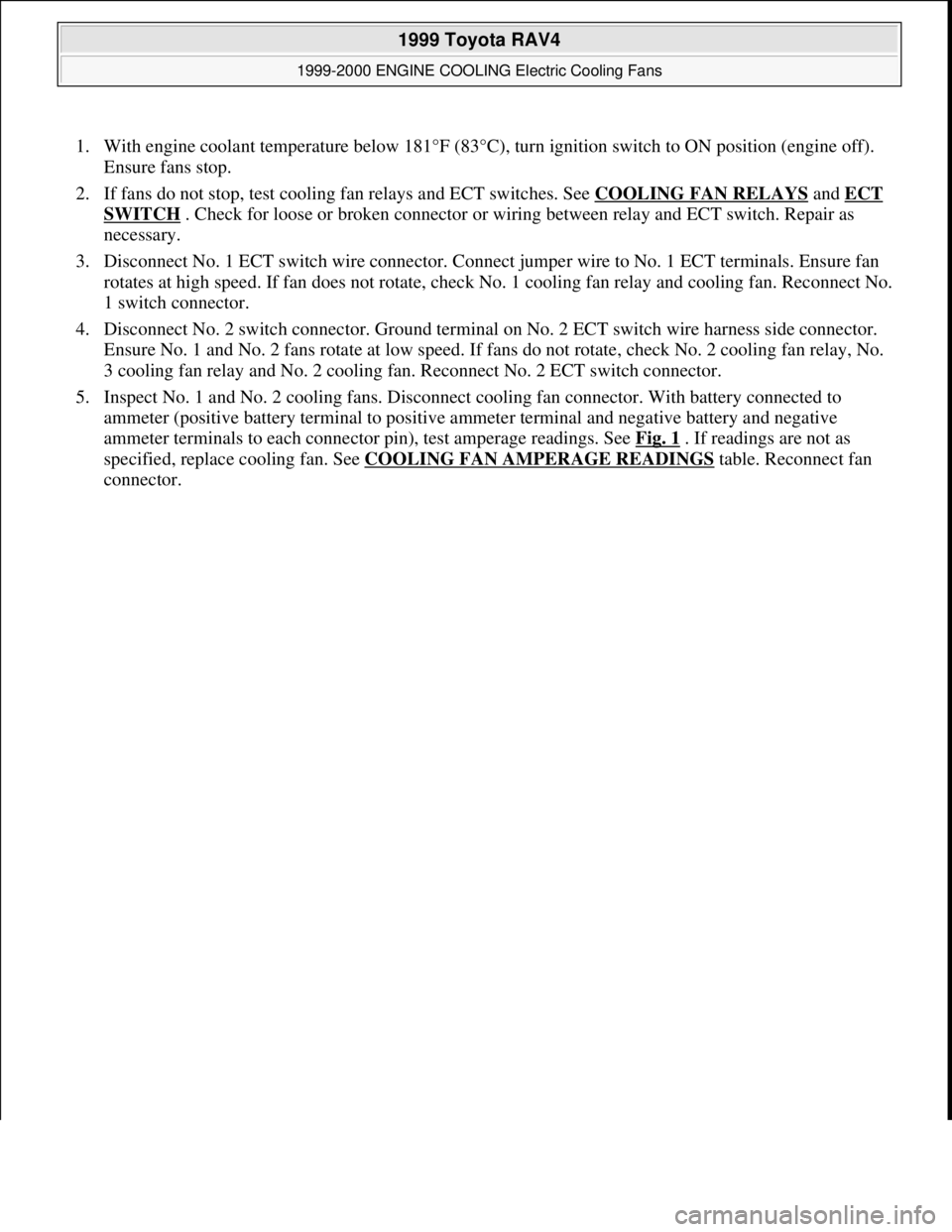
1. With engine coolant temperature below 181°F (83°C), turn ignition switch to ON position (engine off).
Ensure fans stop.
2. If fans do not stop, test cooling fan relays and ECT switches. See COOLING FAN RELAYS
and ECT
SWITCH . Check for loose or broken connector or wiring between relay and ECT switch. Repair as
necessary.
3. Disconnect No. 1 ECT switch wire connector. Connect jumper wire to No. 1 ECT terminals. Ensure fan
rotates at high speed. If fan does not rotate, check No. 1 cooling fan relay and cooling fan. Reconnect No.
1 switch connector.
4. Disconnect No. 2 switch connector. Ground terminal on No. 2 ECT switch wire harness side connector.
Ensure No. 1 and No. 2 fans rotate at low speed. If fans do not rotate, check No. 2 cooling fan relay, No.
3 cooling fan relay and No. 2 cooling fan. Reconnect No. 2 ECT switch connector.
5. Inspect No. 1 and No. 2 cooling fans. Disconnect cooling fan connector. With battery connected to
ammeter (positive battery terminal to positive ammeter terminal and negative battery and negative
ammeter terminals to each connector pin), test amperage readings. See Fig. 1
. If readings are not as
specified, replace cooling fan. See COOLING FAN AMPERAGE READINGS
table. Reconnect fan
connector.
1999 Toyota RAV4
1999-2000 ENGINE COOLING Electric Cooling Fans
Microsoft
Sunday, November 22, 2009 10:21:41 AMPage 2 © 2005 Mitchell Repair Information Company, LLC.
Page 474 of 1632
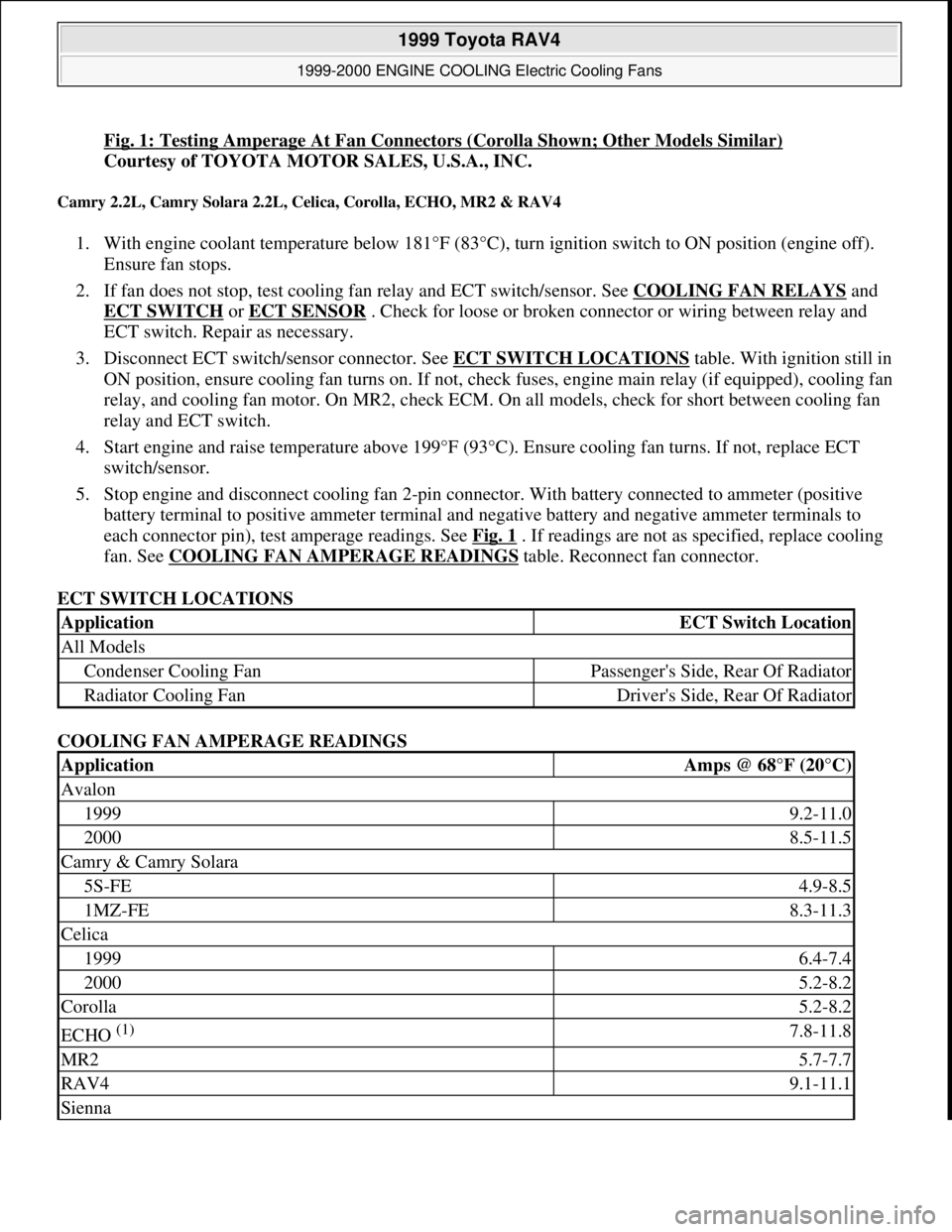
Fig. 1: Testing Amperage At Fan Connectors (Corolla Shown; Other Models Similar)
Courtesy of TOYOTA MOTOR SALES, U.S.A., INC.
Camry 2.2L, Camry Solara 2.2L, Celica, Corolla, ECHO, MR2 & RAV4
1. With engine coolant temperature below 181°F (83°C), turn ignition switch to ON position (engine off).
Ensure fan stops.
2. If fan does not stop, test cooling fan relay and ECT switch/sensor. See COOLING FAN RELAYS
and
ECT SWITCH
or ECT SENSOR . Check for loose or broken connector or wiring between relay and
ECT switch. Repair as necessary.
3. Disconnect ECT switch/sensor connector. See ECT SWITCH LOCATIONS
table. With ignition still in
ON position, ensure cooling fan turns on. If not, check fuses, engine main relay (if equipped), cooling fan
relay, and cooling fan motor. On MR2, check ECM. On all models, check for short between cooling fan
relay and ECT switch.
4. Start engine and raise temperature above 199°F (93°C). Ensure cooling fan turns. If not, replace ECT
switch/sensor.
5. Stop engine and disconnect cooling fan 2-pin connector. With battery connected to ammeter (positive
battery terminal to positive ammeter terminal and negative battery and negative ammeter terminals to
each connector pin), test amperage readings. See Fig. 1
. If readings are not as specified, replace cooling
fan. See COOLING FAN AMPERAGE READINGS
table. Reconnect fan connector.
ECT SWITCH LOCATIONS
COOLING FAN AMPERAGE READINGS
ApplicationECT Switch Location
All Models
Condenser Cooling FanPassenger's Side, Rear Of Radiator
Radiator Cooling FanDriver's Side, Rear Of Radiator
ApplicationAmps @ 68°F (20°C)
Avalon
19999.2-11.0
20008.5-11.5
Camry & Camry Solara
5S-FE4.9-8.5
1MZ-FE8.3-11.3
Celica
19996.4-7.4
20005.2-8.2
Corolla5.2-8.2
ECHO (1) 7.8-11.8
MR25.7-7.7
RAV49.1-11.1
Sienna
1999 Toyota RAV4
1999-2000 ENGINE COOLING Electric Cooling Fans
Microsoft
Sunday, November 22, 2009 10:21:41 AMPage 4 © 2005 Mitchell Repair Information Company, LLC.
Page 492 of 1632
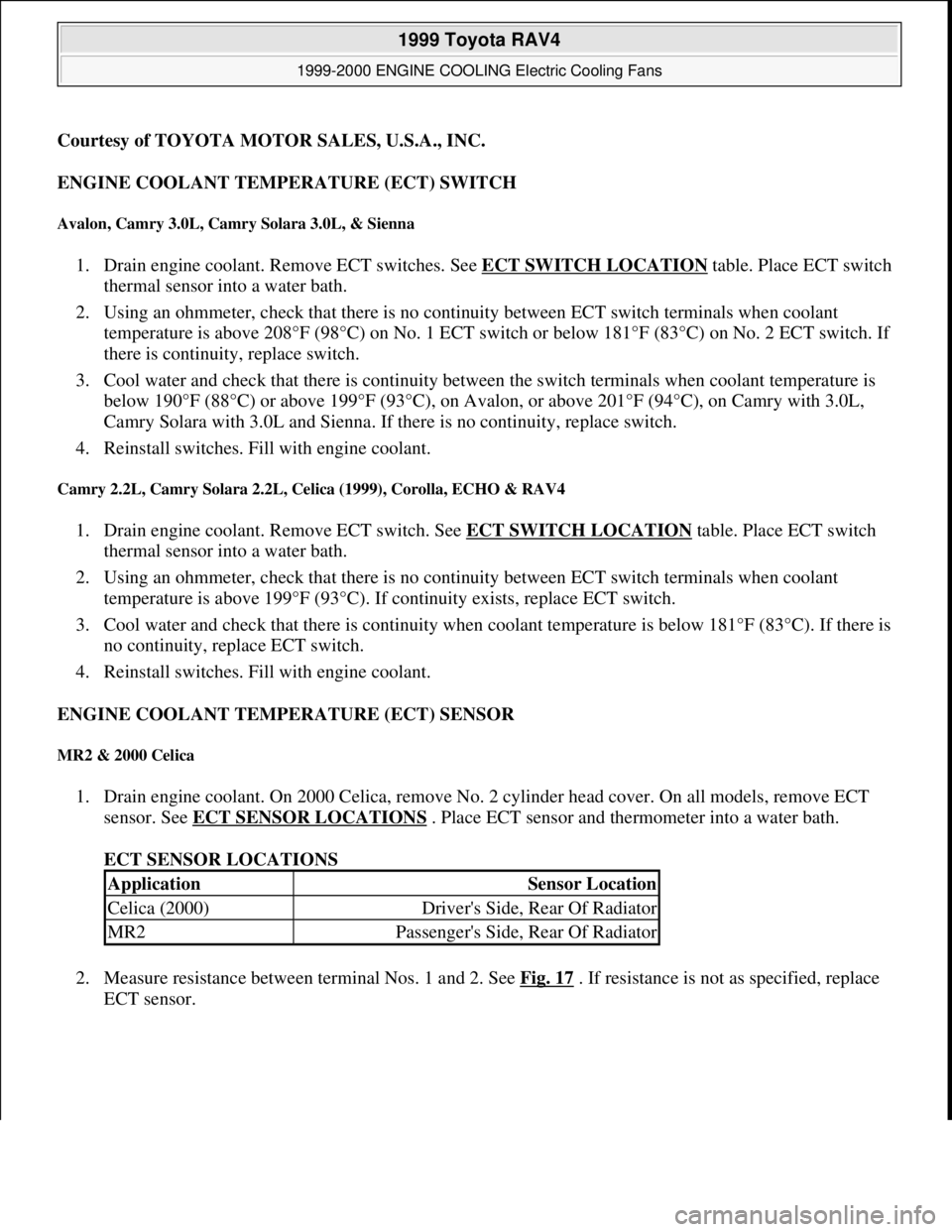
Courtesy of TOYOTA MOTOR SALES, U.S.A., INC.
ENGINE COOLANT TEMPERATURE (ECT) SWITCH
Avalon, Camry 3.0L, Camry Solara 3.0L, & Sienna
1. Drain engine coolant. Remove ECT switches. See ECT SWITCH LOCATION table. Place ECT switch
thermal sensor into a water bath.
2. Using an ohmmeter, check that there is no continuity between ECT switch terminals when coolant
temperature is above 208°F (98°C) on No. 1 ECT switch or below 181°F (83°C) on No. 2 ECT switch. If
there is continuity, replace switch.
3. Cool water and check that there is continuity between the switch terminals when coolant temperature is
below 190°F (88°C) or above 199°F (93°C), on Avalon, or above 201°F (94°C), on Camry with 3.0L,
Camry Solara with 3.0L and Sienna. If there is no continuity, replace switch.
4. Reinstall switches. Fill with engine coolant.
Camry 2.2L, Camry Solara 2.2L, Celica (1999), Corolla, ECHO & RAV4
1. Drain engine coolant. Remove ECT switch. See ECT SWITCH LOCATION table. Place ECT switch
thermal sensor into a water bath.
2. Using an ohmmeter, check that there is no continuity between ECT switch terminals when coolant
temperature is above 199°F (93°C). If continuity exists, replace ECT switch.
3. Cool water and check that there is continuity when coolant temperature is below 181°F (83°C). If there is
no continuity, replace ECT switch.
4. Reinstall switches. Fill with engine coolant.
ENGINE COOLANT TEMPERATURE (ECT) SENSOR
MR2 & 2000 Celica
1. Drain engine coolant. On 2000 Celica, remove No. 2 cylinder head cover. On all models, remove ECT
sensor. See ECT SENSOR LOCATIONS
. Place ECT sensor and thermometer into a water bath.
ECT SENSOR LOCATIONS
2. Measure resistance between terminal Nos. 1 and 2. See Fig. 17
. If resistance is not as specified, replace
ECT sensor.
ApplicationSensor Location
Celica (2000)Driver's Side, Rear Of Radiator
MR2Passenger's Side, Rear Of Radiator
1999 Toyota RAV4
1999-2000 ENGINE COOLING Electric Cooling Fans
Microsoft
Sunday, November 22, 2009 10:21:41 AMPage 22 © 2005 Mitchell Repair Information Company, LLC.
Page 494 of 1632
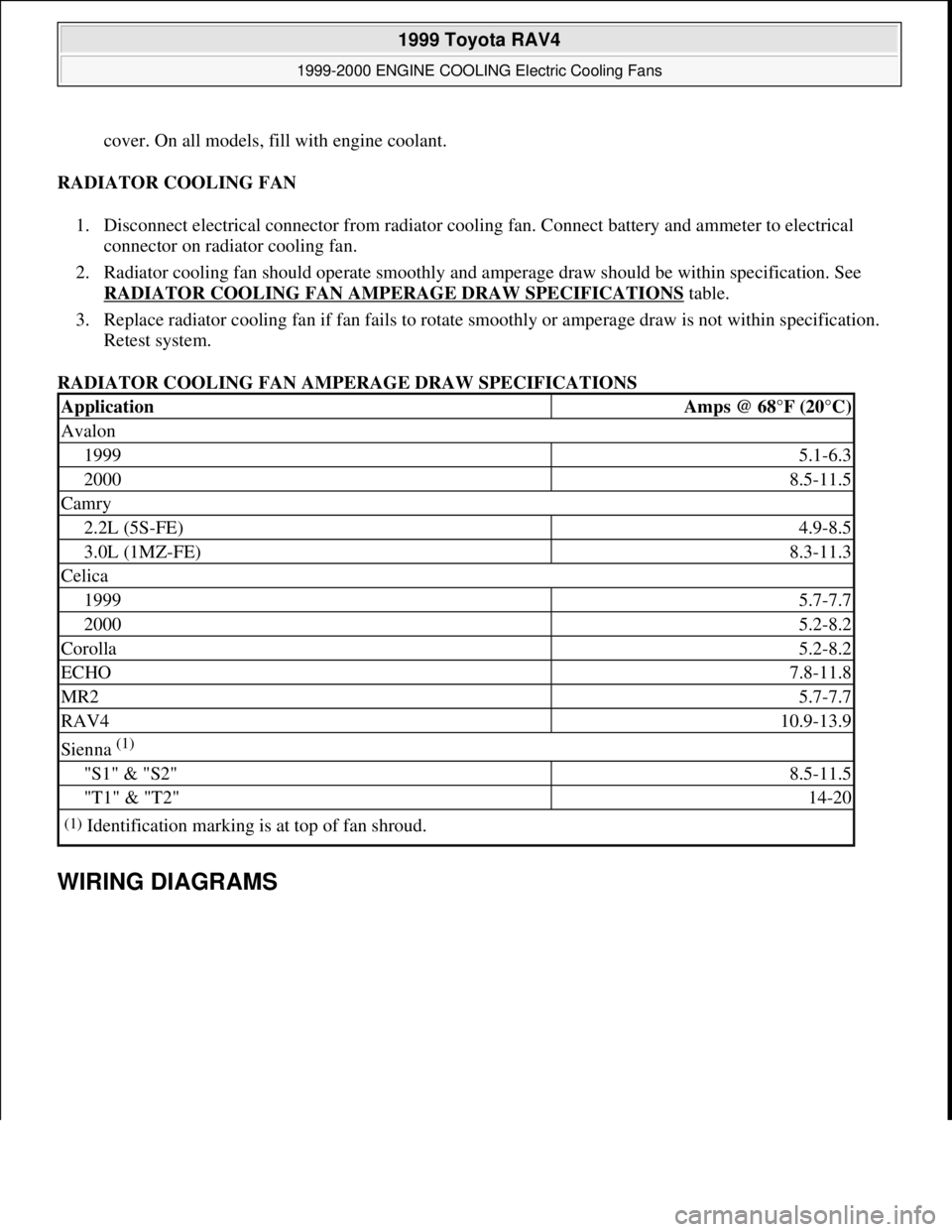
cover. On all models, fill with engine coolant.
RADIATOR COOLING FAN
1. Disconnect electrical connector from radiator cooling fan. Connect battery and ammeter to electrical
connector on radiator cooling fan.
2. Radiator cooling fan should operate smoothly and amperage draw should be within specification. See
RADIATOR COOLING FAN AMPERAGE DRAW SPECIFICATIONS
table.
3. Replace radiator cooling fan if fan fails to rotate smoothly or amperage draw is not within specification.
Retest system.
RADIATOR COOLING FAN AMPERAGE DRAW SPECIFICATIONS
WIRING DIAGRAMS
ApplicationAmps @ 68°F (20°C)
Avalon
19995.1-6.3
20008.5-11.5
Camry
2.2L (5S-FE)4.9-8.5
3.0L (1MZ-FE)8.3-11.3
Celica
19995.7-7.7
20005.2-8.2
Corolla5.2-8.2
ECHO7.8-11.8
MR25.7-7.7
RAV410.9-13.9
Sienna (1)
"S1" & "S2"8.5-11.5
"T1" & "T2"14-20
(1)Identification marking is at top of fan shroud.
1999 Toyota RAV4
1999-2000 ENGINE COOLING Electric Cooling Fans
Microsoft
Sunday, November 22, 2009 10:21:41 AMPage 24 © 2005 Mitchell Repair Information Company, LLC.